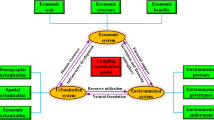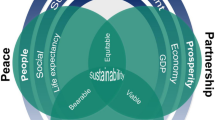Abstract
China’s provinces’ development conditions, levels, and models are quite different. Indeed, the contradictions in development are becoming increasingly prominent, and the task of sustainable development is becoming increasingly arduous. The difference in the coordination degree of the development of the economy, sci-technology, ecology, resources, and society (ESERS), and the influencing factors among the research areas have become the most concerned scientific proposition of regional sustainable development. This paper measures the ESERS coupling and coordinated development relationship among the five development levels of China’s provinces on the coupling coordination model. The spatial autoregressive (SAR) and geographically weighted regression (GWR) models are used to capture the spatial correlation and spatial heterogeneity of the sustainable and coordinated development of various districts in China. The main research conclusions are as follows: (1) the coupling coordination relationship of different regions in China remained at the mild and moderate maladjusted recession stage. In each of the five dimensions (ESERS), the coupling coordination relationship is relatively weak. (2) In terms of temporal distribution, among the four geographical regions of China, except the northeast, the development of ESERS in the eastern, central, and western regions is shifting to a coordinated balance. In terms of spatial distribution, the unbalanced development of ESERS is mainly concentrated in the northeast and part of the western regions. (3) The backward industrial structure is the main reason leading to the unbalanced development of ESERS in China, while the degree of opening up, eco-environmental governance ability, and education investment intensity are the critical factors leading to the development differentiation of ESERS in different regions of China. Overall optimization of industrial structure is the best way to improve the balance of the overall development of ESERS in China, and strengthening human ecology and international construction is the more effective way to narrow the development differences of regional ESERS.









Similar content being viewed by others
Data availability
The datasets generated and analyzed during the current study are not publicly available due [REASON WHY DATA ARE NOT PUBLIC] but are available from the corresponding author on reasonable request.
References
Ahmad M, Chandio AA, Solangi YA et al (2021) Dynamic interactive links among sustainable energy investment, air pollution, and sustainable development in regional China. Environ Sci Pollut Res 28:1502–1518. https://doi.org/10.1007/s11356-020-10239-8
Bilgen S, Sarıkaya İ (2015) Exergy for environment, ecology and sustainable development. Renew Sustain Energy Rev 51:1115–1131. https://doi.org/10.1016/j.rser.2015.07.015
Cai F (2018) Reform and development of the China’s economy. SSAP, Beijing, China
Dabbous A, Tarhini A (2021) Does sharing economy promote sustainable economic development and energy efficiency? Evidence from OECD countries. J Innov Knowl 6(1):58–68. https://doi.org/10.1016/j.jik.2020.11.001
Daniele B, Niu Y, Lisa P et al (2018) A participatory sustainability assessment for integrated watershed management in urban China. Environ Sci Policy 85:54–63. https://doi.org/10.1016/j.envsci.2018.03.020
Duan PL, Liu SG, Yin P, Zhang HF (2018) Spatial-temporal coupling and coordination between the development intensity of coastal cities and the carrying capacity of resources and environment in China. Econ Geography 38(05):60–67. https://doi.org/10.15957/j.cnki.jjdl.2018.05.008
Fang CL, Shi PH, Yu DL (1997) Regional sustainable development and regional development planning. Progress in geography 03:50–55. https://doi.org/10.11820/dlkxjz.1997.03.007
Fang CL, Cui XG, Li GD, Bao C, Wang ZB, Ma HT, Sun S, Liu HM, Luo K, Ren YF (2019) Modeling regional sustainable development scenarios using the urbanization and eco-environment coupler: case study of Beijing-Tianjin-Hebei urban agglomeration. China Sci Total Environ 689:820–830. https://doi.org/10.1016/j.scitotenv.2019.06.430
Han J, He X (2011) Development of circular economy is a fundamental way to achieve agriculture sustainable development in China. Energy Procedia 5:1530–1534. https://doi.org/10.1016/j.egypro.2011.03.262
He ZS, Jiang L, Wang Z, Zeng R, Xu DW, Liu JF (2019) The emergy analysis of southern China agro-ecosystem and its relation with its regional sustainable development. Global Ecology and Conservation 20:e00721. https://doi.org/10.1016/j.gecco.2019.e00721
Hu JY, Liu BJ (2019) Driving analysis of river network evolution in Foshan City Center based on spatial autoregression and geographical weighted regression model. Hydrology 39(02):7–13. https://doi.org/10.3969/j.issn.1000-0852.2019.02.002
Hu ZQ (2021) Ecological environment protection and sustainable development. Huazhong University of Science and Technology Press, Wuhan, China
Ishizaka A, Labib A (2011) Review of the main developments of the analytic hierarchy process. Expert Syst Appl 39:14336–14345. https://doi.org/10.1016/j.eswa.2011.04.143
Jeroen CJM, van den Bergh (2010) Externality or sustainability economics? Ecol Econ, 69(11): 2047-2052.https://doi.org/10.1016/j.ecolecon.2010.02.009
Jesmin FK, Sharif MB (2014) Weighted entropy for segmentation evaluation. Opt Laser Technol 57:236–242. https://doi.org/10.1016/j.optlastec.2013.07.012
Jung C, Kim C, Kim S, Suh K (2018) Analysis of environmental carrying capacity with emergy perspective of Jeju Island. Sustainability 10:1681. https://doi.org/10.3390/su10051681
Kan BY, Pu LJ, Xu CY, Zhu M, Huang SH, Xie ZD (2019) Study on the driving factors of spatial heterogeneity of residential land price in the main urban area of Nanjing Based on GWR Model. Economic Geography 39(03):100–107. https://doi.org/10.15957/j.cnki.jjdl.2019.03.012
Khan SAR, Quddoos MU, Akhtar MH et al (2021) Re-investigating the nexuses of renewable energy, natural resources and transport services: a roadmap towards sustainable development. Environ Sci Pollut Res. https://doi.org/10.1007/s11356-021-16702-4
Kona A, Bertoldi P, Kılkış Ş (2019) Covenant of mayors: local energy generation, methodology, policies and good practice examples. Energies 12:985. https://doi.org/10.3390/en12060985
Li X, Zhou DJ (2016) Research on comprehensive evaluation of financial innovation ability of the national-level new areas based on grey correlation. Shanghai Jiaotong Univ (sci) 21:204–209. https://doi.org/10.1007/s12204-016-1713-4
Liu C, Zhang R, Wang M, Xu J (2018) Measurement and prediction of regional tourism sustainability: an analysis of the Yangtze River Economic Zone. China Sustainability 10:1321. https://doi.org/10.3390/su10051321
Liu L (2011) Where in the world of sustainability education is US geography? J Geogr Higher Educ 35(2):245–263. https://doi.org/10.1080/03098265.2010.548086
Lu J, Chang H, Zhao SP, Xu CJ (2016) The evolution characteristics of the coupling relationship among energy, economy and environment in Shandong Province. Econ Geogr 36(09):42–48. https://doi.org/10.15957/j.cnki.jjdl.2016.09.006
Lu SB, Bai X, Zhang XL, Li W, Tang Y (2019) The impact of climate change on the sustainable development of regional economy. J Cleaner Prod 233:1387–1395. https://doi.org/10.1016/j.jclepro.2019.06.074
Luo SM (2004) Introduction to environmental ecology and sustainable development. China Agricultural Press, Beijing, China
Malik MN, Khan HH, Chofreh AG, Goni FA, Klemeš JJ, Alotaibi Y (2019) Investigating students’ sustainability awareness and the curriculum of technology education in pakistan. Sustainability 11(9):2651. https://doi.org/10.3390/su11092651
Nilashi M, Rupani PF, Rupani MM, Kamyab H, Aljojo N (2019) Measuring sustainability through ecological sustainability and human sustainability: a machine learning approach. J Cleaner Prod 240:118162. https://doi.org/10.1016/j.jclepro.2019.118162
Ouyang F, Zhou J (1996) Sustainable development: the only route that China move towards the future. Sci Technol Dialectics 04:6–10
Pearce D, Atkinson G (1995) Measuring sustainable development. The Handbook of Environment Economics, Blackwell, Oxford
Ren BP, Wen FA (2018) The judgment standard, decisive factors and realization way of China’s high quality development in the new era. Reform 04:5–16
Ren JL (2019) Introduction to regional sustainable development. Science Press, Beijing, China
Ristić D, Vukoičić D, Milinčić M (2019) Tourism and sustainable development of rural settlements in protected areas – example NP Kopaonik (Serbia). Land Use Policy 89:104231. https://doi.org/10.1016/j.landusepol.2019.104231
Sulewski P, Koczko-Gajewska A (2018) Relations between agri-environmental, economic and social dimensions of farm sustainability. 166th Seminar, August 30–31, 2018, Galway, West of Ireland. European Association of Agricultural Economists. https://doi.org/10.22004/ag.econ.276202
Titova ES (2019) Biofuel application as a factor of sustainable development ensuring: the case of Russia. Energies 12:3948. https://doi.org/10.3390/en12203948
Xiao GX (2018) Space statistics practice. Science Press, Beijing, China
Xie BG, Chen YL, Li XQ (2016) The application of coupling coordination model in the construction evaluation of “beautiful China.” Economic Geography 36(07):38–44. https://doi.org/10.15957/j.cnki.jjdl.2016.07.005
Xu J, Cao Y (2019) Innovation, the flying geese model, IPR protection, and sustainable economic development in China. Sustainability 11:5707. https://doi.org/10.3390/su11205707
Yan X, Cheng CC, Zhou LJ (2017) A study on the coordinated development of economic development, innovation capacity and ecological environment in the Yangtze River Economic Belt. Sci Technol Manag Res 37(19):85–93. https://doi.org/10.3969/j.issn.1000-7695.2017.19.013
Yu HP (1999) The study of Chinese modern economic history in the past 50 years. Modern Chin Hist Stud 05:47–70
Yuan BL, Zhang Y (2020) Flexible environment policy, technological innovation and sustainable development of China’s industry: the moderating effect of environment regulatory enforcement. J Cleaner Prod 243:118543. https://doi.org/10.1016/j.jclepro.2019.118543
Yue W, Bao ZH (2019) The course, achievement and enlightenment of economic modernization in the 70 years since the founding of new China. Enterprise Economy, 10, 1–7. https://doi.org/10.13529/j.cnki.enterprise.economy.2019.10.002
Zhang, J. K., Hou, Y. Z., Liu, P. L., He, J. W., Zhou, X. (2019). Target requirements and strategic path of high quality development. Management World, 35(07), 1–7. https://doi.org/10.19744/j.cnki.11-1235/f.20190711.001
Zhang JT, Liu LL (2008) Urban and regional sustainable development. Dongbei University of Finance & Economics Press, Dalian, China
Zhao L, Li L, Wu Y (2017) Research on the coupling coordination of a sea–land system based on an integrated approach and new evaluation index system: a case study in Hainan Province. China Sustainability 9:859. https://doi.org/10.3390/su9050859
Zhu ZR (2010) Problems and suggestions of regional sustainable development in China. Shandong Textile Economy 06:12–14. https://doi.org/10.3969/j.issn.1673-0968.2010.06.002
Author information
Authors and Affiliations
Contributions
Xiao-yu Liu: conceptualizationa and writing—review and editing. Yun Xin: conceptualization, methodology, software, data curation, and writing—original draft preparation.
Corresponding author
Ethics declarations
Ethics approval
Not applicable.
Consent to participate
Agree to participate.
Conflict of interest
Agree to publish.
Competing interests
The authors declare no competing interests.
Additional information
Responsible Editor: Eyup Dogan
Publisher's note
Springer Nature remains neutral with regard to jurisdictional claims in published maps and institutional affiliations.
Rights and permissions
About this article
Cite this article
Liu, X., Xin, Y. Exploring the characteristics and driving factors of coupling coordination of regional sustainable development: evidence from China’s 31 provinces. Environ Sci Pollut Res 29, 71075–71099 (2022). https://doi.org/10.1007/s11356-022-20792-z
Received:
Accepted:
Published:
Issue Date:
DOI: https://doi.org/10.1007/s11356-022-20792-z




